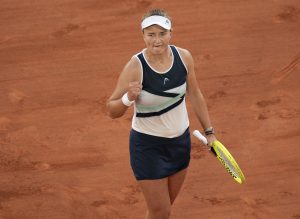You’ve thought long and hard over this. Some days you couldn’t be more sure. Other days you have no idea. Though one thing is for certain: as a new decade begins, the debate has never been more debatable. Who is the GOAT of men’s tennis?
But just one second, ladies and gentlemen of the court. Before closing arguments are made, and final verdicts are reached, should we not first take a beat to know what we’re judging? What exactly is this proverbial GOAT?
Besides being an acronym totally unrelated to the four-hoofed mammal, it’s been our culture’s shorthand for the “Greatest Of All Time” over the past few years. The now ubiquitous term first surfaced circa 1992, when Muhammed Ali’s wife named his personal licensing business G.O.A.T. Inc. Eight years later, our friend LL Cool J dropped an album titled G.O.A.T. But what does it really mean to be the Greatest Of All Time? Does it mean the Best Of All Time? Does greatness mean best? Is the GOAT, also the BOAT? We should probably find out.
For starters, deciding the Best Of All Time is more objective. “Best” is substantiated with facts and stats. It’s a quantitative evaluation backed by indisputable evidence. While the GOAT, on the other hand, is more subjective. What’s great to one person, might not be to the next. Exhibit A: LL Cool J. Greatness is a qualitative measurement, with intangibles that carry more human value than numeric. And while math has never lost a match in its life, it rarely wins hearts and minds.
That being said, let’s be adults about this, and do the responsible thing here by first establishing the facts before foolishly running off to explore the ambiguity and nuances of the ineffable GOAT.
How about starting where most do; Grand Slams. The four most prestigious tournaments on earth, with the most ranking points and prize money at stake. Roger Federer is 38 years old, and has amassed a whopping 20 grand slams. Rafael Nadal is 33, and has 19. Novak Djokovic, 32, with 17.
Yes, but what if they all began their careers at the same time, at the same age? Like an itch you can’t help but scratch, this is the question you can’t help but ask. Which, is the rub of any GOAT conversation, for any sport. Jordan v Lebron. Tiger v Nicklaus. The impossibility of a multiverse where every great athlete in history plays in their prime at the same time, under the same conditions, same rules, same equipment—during their entire career. Alack, what we’d like to be apples-to-apples can sometimes feel more akin paper clips and spaceships.
Stay with me, here. Roger bagged 16 slams by the time he was 28 years old (Arguably a professional tennis player’s prime age before the body begins a gradual decline). Rafa had 14 by the age of 28. And Novak, 10. After the age of 28, Roger has won four grand slams. Rafa, five. Novak, seven.
So what? Well, one can’t help but postulate, if Rafa and Novak started at the same time as Roger, they likely would have stolen some of his first 16 GSs…though on the flipside, Roger may have snagged more slams from the two of them at 28 and on. A see-saw of outcomes. Maybe a wash in the end? There’s literally no way to know, and no way not to speculate.
Side Note: To confuse matters worse, Pete Sampras won 12 GSs by the time he was 28 years old, and retired when he was 31. Bjorn Borg won 11 by the time he was 25 (read twenty-five). Then retired at 25. AND, BTW, he only played the Australian Open ONCE.
But how about life after grand slams? Four tournaments a year can’t mean everything, right? The next indicator of GOAT status is typically measured by the number one ranking. How long can one play king of the mountain with the rest of the world?
Most Weeks Ranked Number One:
Federer – 310
Sampras – 286
Djokovic – 282
Ivan Lendl – 270
Jimmy Connors – 268
Nadal – 209
Most Year-End Number One Rankings:
Sampras – 6
Connors – 5
Federer – 5
Djokovic – 5
Nadal – 5
And lest we forget total wins. How many times did they raise a strange looking trophy and say cheese?
Most Total Tournament Wins
Connors – 109
Federer – 103
Lendl – 94
Nadal – 85
Djokovic – 79
John McEnroe – 77
Hmm. Are you thinking what I’m thinking? Is there a difference between who was the greatest, and who was the greatest the longest? And just because you played longer, does it necessarily mean you’re better? Or just because you were better longer, does that mean you’re the best? Inexplicably, the more we look at the numbers, the more oblique it becomes. No?
Maybe what’s more telling than total wins, is winning percentage?
Highest Career Winning Percentage
Nadal – 83.2%
Djokovic – 83.0%
Borg – 82.7%
Federer – 82.1%
Hold on, you didn’t happen to forget that Nadal has a 91.8% on clay, did you? Good, because that’s one more variable to consider—playing surfaces. If we take clay out of the equation, Rafa only has seven slams. No grass, and Roger has 12. Let the turf wars begin.
Confused yet? Same here. Perhaps even more insightful than winning percentage, is head-to-head results then? Is this the closest we can get to apples-to-apples?
Head-to-Head Records:
Nadal 24 — Federer 16
Novak 26 — Federer 22
Novak 29 — Nadal 26
Wait, no cogent GOAT analysis is complete without mention of fate’s sudden and cruel neutralizer—injuries. All athletes face them, some more than others. Doesn’t necessarily gauge how great you are; but does affect how great you could have become.
Injuries Impacting Grand Slams
Federer – Missed 4 slams, Retired from 0 slams
Nadal – Missed 6 slams, Retired from 3 slams
Djokovic – Missed 1 slam, Retired from 4 slams
So how’s your arithmetic? Synapses firing like Nick Kyrgios’ T-serve? Friends, we are steeped in a mathematical rabbit hole that goes deeper than a John Isner 5th set. And even if you have, by some great human feat, built a GOAT calculator that can process endless variables within infinite scenarios, this impasse doesn’t stop there. Oh, no. You may have determined a BOAT, but that doesn’t mean you’ve got a GOAT.
And here’s why: the GOAT represents less a statistic, and more an embodiment. Encapsulating a caliber of excellence that doesn’t fit into words or numbers. Counting not just what is won, but how it’s won. A reflection of what our culture holds most high. Or in other words, a record book doesn’t tell the whole story, because record books don’t have two eyes and a soul.
So enough with the numbers already. Here are a few new acronyms that add a much-needed element of humanity to the equation. Suggesting that maybe this indelible GOAT is more than the number of majors they hold.
The BOOT: Best Of One Time
Forget career stats. Who cares how long they played. Who was, at any given moment, the absolute best tennis player to ever touch a tennis racket? Full stop. Whose best day, beats all other’s best days? Whose world domination, dominates all others’? Federer in 2006? Nadal in 2010? Djokovic in 2015?
The COAT: Competitor Of All Time
Great champions die hard. And they can seemingly come back from the grave. If they have you down, they’ll step on your neck to keep you there. They are inexorably cutthroat. Their unflappable moxie knows no other way. Winning isn’t everything, it’s the only thing. Sweep the leg.
The CAT: Clutchest All Time
When the moment cannot get any bigger, whose game always does? Who can talk their nerves off the ledge, and then calmly ascend to the Zen place where everything slows down except their perfectly placed winners? Who makes playing inside a pressure-cooker look like a cool breeze?
The BETA: Best Ever Tennis Athlete
Power. Speed. Agility. Like a lion who rules sovereign over its native grasslands, this player demonstrates a physical command over the tennis court. Noticeably faster, stronger, and defter to the naked eye. Cat-like reflexes paired with unbridled horsepower, and wings to boot.
The MAPE: Most Artful Player Ever
Part athlete, part avant-garde. This virtuoso treats the court as their canvas. Introducing new strokes out of thin air, improvising with vision and imagination. Their form is aesthetically pleasing. The result is a portrait of the game that never gets old to gaze at.
The SOAT: Sportsman Of all time
Rooted in respect for the game, for their opponent, and for the spectators, their character blooms integrity, class and grace that make us all proud to be tennis fans. They win in ways that transcend white lines and a net.
The PORT: Prince Of Raw Talent
Like many superheroes, they were born with a primordial gift. Their hand-eye coordination is from another planet. They don’t run, they glide. They flex in ways that mere mortals do not. They are genetic royalty. No one has more natural tools to work with.
If you’re still reading this, I have some good news: there’s a high likelihood you’re a tennis fan. And as a fan, you know full well that it’s our duty, nay, our moral obligation, to uphold the integrity of public opinion by telling people our own opinion and getting them to agree with it.
So in closing. Carefully consider all the evidence. Deliberate amongst your peers. If the jury cannot come to a resolution, it may choose to wait for new evidence over the coming years, and then reach a final ruling once the GOAT contenders have concluded play.
And don’t forget, greatness is measured in many ways. Which is why it’s so great to debate.
Just ask LL Cool J.
Main Photo:






